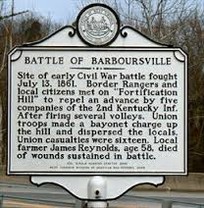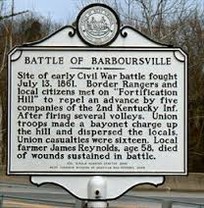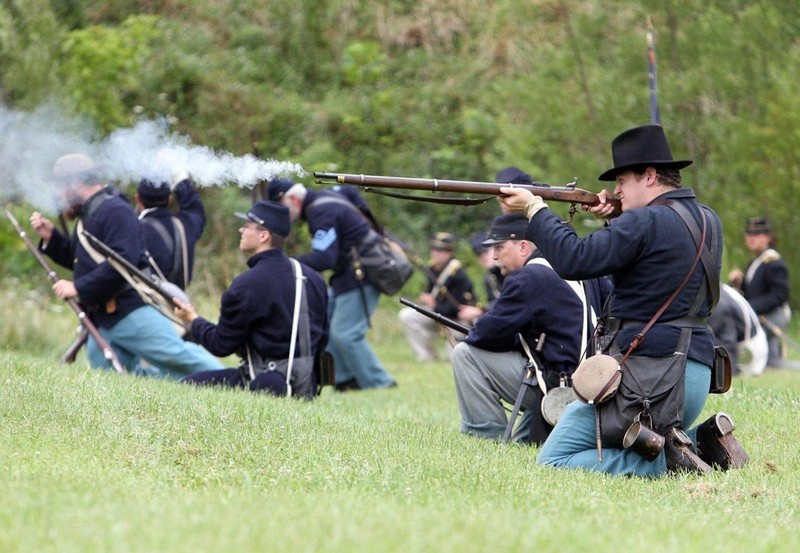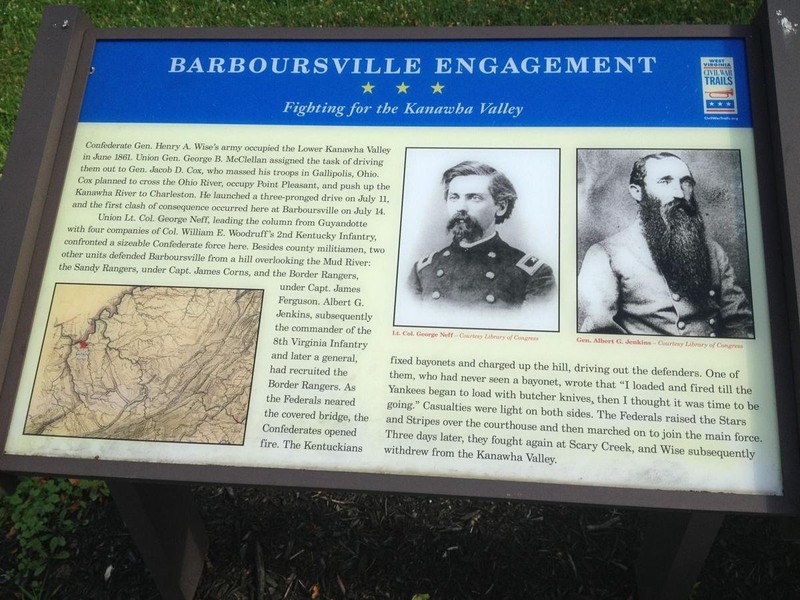Battle of Barboursville Historical Marker
Introduction
Text-to-speech Audio
Images
This historical marker can be found along US 60/Midland Trail


Picture of a reenactment of Union Soldiers at the battle of Barborsville.

This marker was dedicated in 2010 and is located in the middle of the park.

Backstory and Context
Text-to-speech Audio
As part of a 3-pronged invasion of Northwest Virginia (now West Virginia) in 1861, Union forces headed to the major town of Charleston to capture and secure the area for the Union and protect the states that border the area (Pennsylvania, Ohio and border state Kentucky), one columnn headed into the Guyandotte/Kanawha Valley. Lying along the Ohio River offered a major strategic advantage which both major forces wished to exploit. This area soon to be West Virginia eventually became an important goal to secure for the Union War effort a few years later. Thus it makes sense that early engagements including the also disputed first land engagement (or skirmish, hence the debate) of the Civil War, resulting in a confederate retreat from overwhelming high ground Union artillery, was fought in nearby Philippi [1].
The sense of division within the border region of the war is often understated. Union forces occupied Guyandotte, just over 5 miles from Barboursville, in the days preceding the engagement in due to local civil unrest involving seizure of a steamboat. Upon occupation of the Union forces, many citizens took an oath of loyalty to the union, where only days prior many had celebrated delivery of the news that their state of Virginia had seceded from the Union [2]. It is even recalled by some sources that a former local of Guyandotte, Mrs. Caroline White, returned to the area presenting union colors upon her arrival so as to celebrate the now Union controlled town [3].
After the steamboat seizure near May 25th, former politician Albert Jenkins, sensing an impending conflict, returned to the Barboursville area to begin training a division of Confederate forces to defend Barboursville [2]. On July 13, 1861, citizens of Barboursville and men from Wayne, Lincoln, and Cabell counties gathered on a prominent hill in town. They were commanded by Col. Ferguson of the Jenkins Border Rangers, with additional strength from Capt. James Corn, and the Sandy Rangers. Approximately 600 troops total in strength. Fortifications were made on the hill hence the nickname "Fortification Hill". They faced the 2nd KY Infantry under Col. Woodruff.
On July 14-15, Col. Woodruff and the 2nd KY Inf. advanced on Barboursville. After exchanging a few volleys the over-confident but poorly trained and ill-armed Confederate forces and militia were driven from both the hill and town via a wooden covered bridge nearby. Reports from the defeated Rebels stated that the defenders of the Hill, when seeing the bayonets of the Union's rifles, had feared that the Union had started to "shoot knives at us." This image had frightened the Rebels, causing them to retreat. James Reynolds of Milton (militia) was killed and a reported 5 wounded. Union forces suffered 5 killed 18 wounded. The victors then secured the town. Days later, the same forces clashed in the lower Kanawha near Scary Creek. Later that year in November, Jenkins Rangers sought revenge by ambushing a Union force camped in the port town of Guyandotte near modern-day Huntington and drove the Union out. The Union forces returned and burned about 2/3 of the town.
On September 8, 1862, Barboursville suffered another minor battle when the previous defenders, Jenkins Rangers (Jenkins was a Cabell local and VA Politician with a plantation nearby) attacked the Ohio Cavalry encamped in the town. The fighting took place along Main Street near modern-day Nancy Cartmill Gardens, interrupting church services. One Union soldier was killed. The battle ended in a draw, with both forces leaving the battle area, Confederate forces were able to maintain a hold on Barboursville. With the town secured in CSA hands, Jenkin's Rangers were able to then invade/raid into parts of Ohio. The Northwest counties of VA voted and eventually left Virginia and rejoined the Union on June 20th, 1863, becoming the 35th state.
Sources
Cabell-Wayne Historical Society of West Virginia. 630 1/2 7th Ave, Huntington, WV. https://www.facebook.com/KyovaGenealogicalAndHistoricalSociety
[1] Dayton, Ruth Woods. Philippi -- The Beginning. Edition 4. Volume 13. 1952.
[2]Geiger, Joe. The Tragic Fate of Guyandotte. Volume 54. 1995.
Herald-DispatchHerald-Dispatch.com, 2. (2010, December 02). Battle of Barboursville site added to Civil War Trails program. Retrieved June 29, 2019, from https://www.herald-dispatch.com/news/recent_news/battle-of-barboursville-site-added-to-civil-war-trails-program/article_80a622b1-4448-5a96-81dd-3a6b66b1fc37.html
Herald-Dispatch, B. R. (2012, July 20). Barboursville Civil War Days kicks off Friday. Retrieved June 29, 2019, from https://www.herald-dispatch.com/news/recent_news/barboursville-civil-war-days-kicks-off-friday/article_4daa9a85-cb1b-58e4-9ea0-77343a5fba65.html
Rowsey, Jeanette M., "The Lost Village of Barboursville: Unsung and Vanishing History of the Best Little Village in West Virginia (1813-2013). JRC Publishing, Barboursville, WV. Gunter, Frances B. "Barboursville." 1999. Franklin Printing, Huntington, WV. http://www.lostvillageofbarboursville.com/index.html
[3] Unknown Author. May 1st-3rd Battle of Barboursville, March 30th 2015. Accessed March 8th 2020. https://wiselegion.blogspot.com/2015/03/may-1st-3rd-battle-of-barboursville.html.
